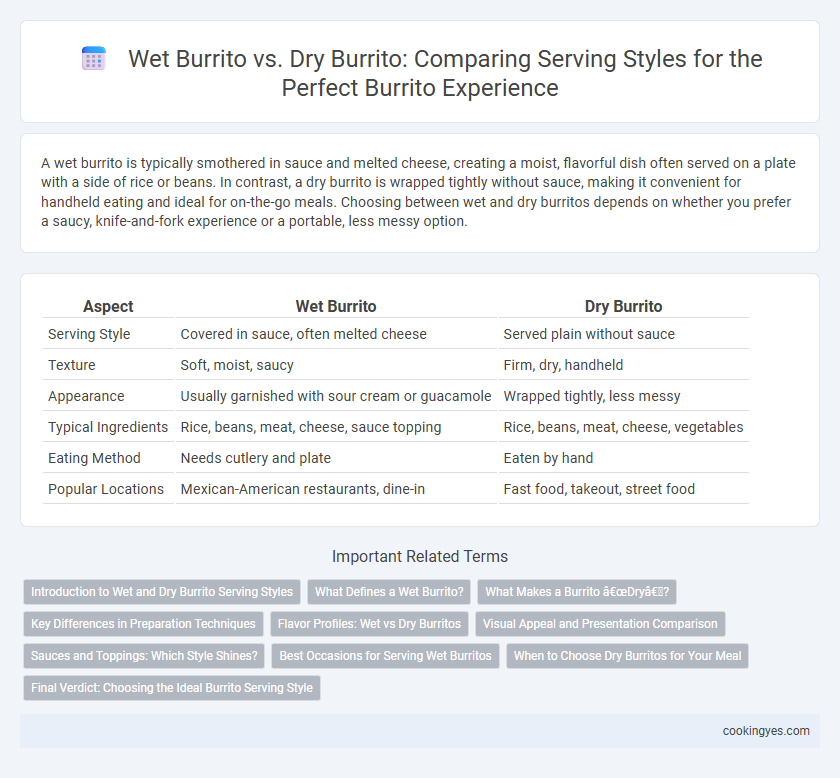A wet burrito is typically smothered in sauce and melted cheese, creating a moist, flavorful dish often served on a plate with a side of rice or beans. In contrast, a dry burrito is wrapped tightly without sauce, making it convenient for handheld eating and ideal for on-the-go meals. Choosing between wet and dry burritos depends on whether you prefer a saucy, knife-and-fork experience or a portable, less messy option.
Table of Comparison
| Aspect | Wet Burrito | Dry Burrito |
|---|---|---|
| Serving Style | Covered in sauce, often melted cheese | Served plain without sauce |
| Texture | Soft, moist, saucy | Firm, dry, handheld |
| Appearance | Usually garnished with sour cream or guacamole | Wrapped tightly, less messy |
| Typical Ingredients | Rice, beans, meat, cheese, sauce topping | Rice, beans, meat, cheese, vegetables |
| Eating Method | Needs cutlery and plate | Eaten by hand |
| Popular Locations | Mexican-American restaurants, dine-in | Fast food, takeout, street food |
Introduction to Wet and Dry Burrito Serving Styles
Wet burritos are typically smothered in rich sauces like red chili or green tomatillo, enhancing flavor and moisture, while dry burritos are wrapped tightly without any sauce, offering a handheld, less messy experience. Wet burritos are served on a plate with melted cheese and sauce poured on top, ideal for knife-and-fork dining, whereas dry burritos are perfect for on-the-go consumption, focusing on portability and convenience. Choosing between wet and dry burritos depends on personal preference for texture, taste intensity, and dining setting.
What Defines a Wet Burrito?
A wet burrito is defined by its generous coating of savory red or green chili sauce, baked with melted cheese on top, creating a saucy and rich serving style that contrasts with the dry burrito. Typically served on a plate with a fork and knife, the wet burrito offers a moist texture that enhances the flavors of the seasoned meat, beans, rice, and other fillings inside a flour tortilla. This style emphasizes a hearty, smothered presentation distinct from the handheld dry burrito, making it a popular choice in Tex-Mex cuisine.
What Makes a Burrito “Dry”?
A dry burrito is characterized by its lack of sauce or toppings, relying solely on the tortilla to encase the fillings such as rice, beans, meat, and cheese. Unlike wet burritos, which are smothered in sauces like red chili or enchilada sauce and often baked with melted cheese on top, dry burritos maintain a handheld, less messy serving style. The absence of liquid or sauce preserves the burrito's firm texture, making it ideal for on-the-go consumption and easy dipping.
Key Differences in Preparation Techniques
Wet burritos are typically smothered in rich, savory sauces such as red chili or green tomatillo, which gives them a moist, flavorful exterior. Dry burritos feature a folded, un-sauced tortilla with fillings tightly wrapped inside, resulting in a firmer texture and a focus on the internal ingredients. The primary preparation difference lies in the sauce application; wet burritos are baked or covered with sauce before serving, while dry burritos rely on the tortilla's structure to contain the fillings without added moisture.
Flavor Profiles: Wet vs Dry Burritos
Wet burritos are smothered in savory sauces like red chili or cheese, enhancing moisture and rich, tangy flavors that penetrate each bite. Dry burritos showcase a crisp, toasted tortilla exterior with fillings that emphasize fresh ingredients and bold, distinct textures. The wet style offers a saucy, hearty experience, while the dry burrito delivers a crunchy, vibrant contrast in flavor profiles.
Visual Appeal and Presentation Comparison
Wet burritos feature a vibrant presentation with a generous topping of red or green chili sauce, melted cheese, and often a dollop of sour cream, creating a glossy, saucy appearance that enhances visual appeal. Dry burritos, wrapped tightly with no external sauce, offer a clean, crisp look showcasing the golden-brown tortilla, appealing to those who prefer a neat, handheld presentation. The saucy exterior of wet burritos tends to make serving more complex but visually more enticing, while dry burritos prioritize portability and simplicity in presentation.
Sauces and Toppings: Which Style Shines?
Wet burritos are generously smothered in savory sauces such as red chili, green chili, or creamy queso, creating a moist and flavorful experience enhanced by melted cheese and sour cream toppings. Dry burritos, in contrast, rely on a tightly wrapped flour tortilla to encase the fillings without additional sauce, emphasizing the texture of fresh ingredients like lettuce, tomatoes, and shredded cheese. When it comes to sauces and toppings, wet burritos shine by offering a rich, saucy finish, while dry burritos highlight the crispness and individual flavors of their fresh toppings.
Best Occasions for Serving Wet Burritos
Wet burritos, characterized by their smothered sauce and melted cheese, are ideal for hearty meals and comfort food occasions. They are best served at casual gatherings, celebrations, or family dinners where a rich, indulgent dish is appreciated. The saucy texture enhances the eating experience, making wet burritos perfect for colder weather or festive events requiring a satisfying main course.
When to Choose Dry Burritos for Your Meal
Dry burritos are ideal for meals where portability and ease of eating are priorities, such as picnics or on-the-go lunches. They maintain their shape without the mess of sauce, making them perfect for casual dining or takeout. Choose dry burritos when you prefer a more traditional, handheld experience without the sogginess that comes from wet burritos.
Final Verdict: Choosing the Ideal Burrito Serving Style
Wet burritos feature a hearty filling smothered in rich sauce and melted cheese, creating a moist and flavorful bite ideal for those seeking a saucy texture. Dry burritos, wrapped tightly without sauce, offer a portable and less messy option that highlights the seasoned ingredients and allows for easy on-the-go consumption. Selecting between a wet or dry burrito depends on personal preference for either indulgent moisture or convenient handheld eating.
Wet burrito vs dry burrito for serving style Infographic

 cookingyes.com
cookingyes.com